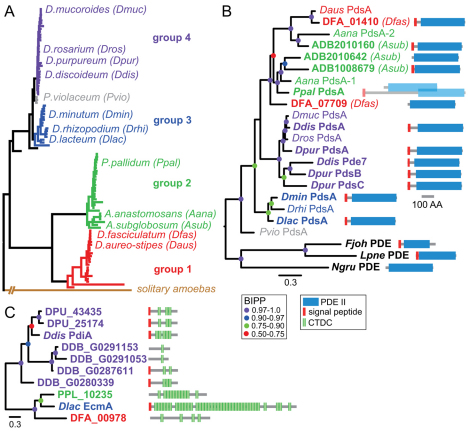Fig. 1.
Identification of PdsA and PdiA genes across the Dictyostelid phylogeny. (A) Schematic representation of the Dictyostelid phylogeny as inferred from SSU rRNA sequences and 18 orthologous genes obtained from fully sequenced genomes (Schaap et al., 2006) (A. Skiba and P.S., unpublished). The positions of species that were used in this work are shown. (B) Partial (regular text) or complete (bold text) PdsA coding sequences were obtained by PCR, cloning from a genomic library or BLAST query of genome sequencing projects. The multiple Asub (ADB), Dfas (DFA) and Dpur (DPU) sequences are named by their locus tags. The PDE-II domains of the derived protein sequences were aligned with the PDE-II domains of three related non-dictyostelid PDE-II proteins using CLUSTALW (Chenna et al., 2003). The alignment was used to assess phylogenetic relationships between the sequences by Bayesian inference (Ronquist and Huelsenbeck, 2003) using a mixed amino acid model with rate variation across sites estimated by a gamma distribution with a proportion of invariable sites. Posterior probabilities for the position of the tree nodes are indicated by coloured dots. The complete coding sequences are annotated with the domain architecture of the proteins. Ppal PdsA is transcribed from multiple promoters and generates two different proteins by alternative splicing (see Fig. 4). (C) The closest Ddis PdiA homologues in group-representative taxa were obtained by BLAST query of genome sequencing projects. An alignment of the full length protein sequences was used to construct a phylogenetic tree by Bayesian inference, which was decorated with the domain architecture of the proteins.

